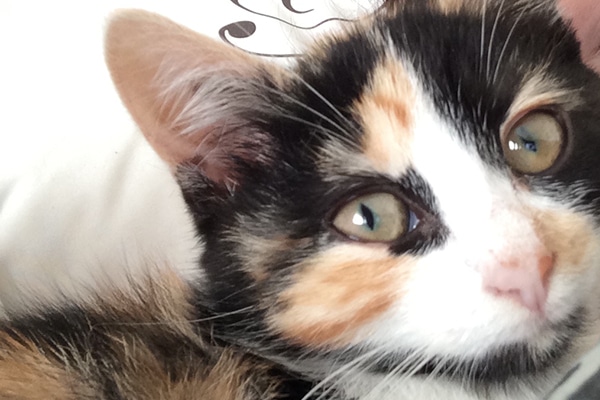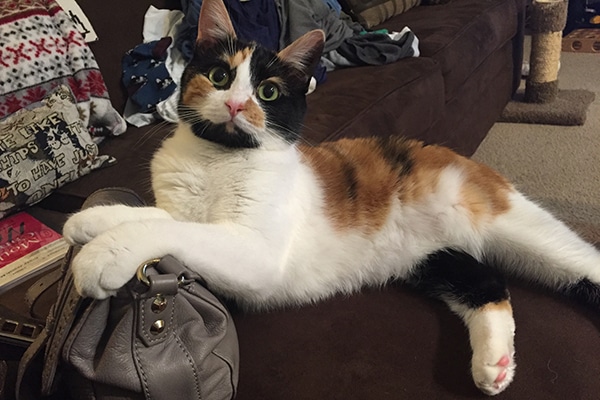Why Does My Cat’s Nose Change Color?
The post Why Does My Cat’s Nose Change Color? by Cait Rohan Kelly appeared first on Catster. Copying over entire articles infringes on copyright laws. You may not be aware of it, but all of these articles were assigned, contracted and paid for, so they aren't considered public domain. However, we appreciate that you like the article and would love it if you continued sharing just the first paragraph of an article, then linking out to the rest of the piece on Catster.com.
This first time I noticed that my calico cat Merritt’s nose seemed pinker than usual, I thought I was imagining it. But when it happened again and again I got curious and a bit concerned. Merritt’s pale pink nose would turn a bright, hot pink when she was excited or after a bout of fetch (yep, she’s one of those doglike cats!). This got me thinking: why does my cat’s nose change color — and is it normal?

Merritt as a kitten, at rest with a very light pink nose. Her cute little nose freckle (more on that later!) wasn’t there yet! Photography courtesy Cait Rohan Kelly.
Why does your cat’s nose change color?
If, like me, you’ve noticed your cats nose getting brighter and more vibrant like some sort of kitty Rudolph on a foggy Christmas Eve, you’re not alone.
“Cats noses can change color from light pink to darker pink, normally in times of excitement or stress due to a temporary elevation in heart rate and blood pressure,” says Jenny Kistler, DVM at Brandermill Animal Hospital in Midlothian, Virginia. “This is a normal event and is usually nothing to worry about as long as it is short term.”
Related: 4 Cool Facts About Cat Noses
Dr. Sasha Gibbons of Just Cats Veterinary Hospital in Stamford, Connecticut, says that temperature also plays a role in a cat’s nose changing color. “The cat’s nose is highly vascularized (which means it has numerous small blood vessels throughout it),” Gibbons says.“These blood vessels can grow or shrink with different variables (such as heat, cold and high or low blood pressure). This can cause variations in the pink coloration of the nose. For instance, when a cat is cold, the blood vessels are smaller so the nose might appear light pink. When a cat is hot, or blood pressure raises, the vessels are larger so the nose may appear darker pink or red.”
Do cat nose color changes only happen in certain kitties?
We are a two-cat household but I only see the color changes happen to Merritt’s nose. My other cat, Gabby, is a colossally large and lazy tabby who doesn’t play or get excited about much in life (besides catnip). He has a pink – albeit a darker, more pigmented pink — nose.
In turns out that this phenomenon is simply more noticeable in some cats. “All cats have the same anatomy of the nose, but the variations are much easier to see in cats with light-colored noses,” says Dr. Gibbons.
How are these nose color changes different from nose freckles? Should you ever worry about those?
You may be reading this article thinking, “but what about those little dots on my cat’s nose?!” Good news — those spots, aka nose freckles or lentigo, are normal, too. And, like a cat’s nose changing colors, they also only show up on certain kitties.
“Freckles can appear in cats carrying the gene for red color, such orange- or cream-colored tabby cats and calicos,” Dr. Jane Brunt, CATalyst Council executive director and American Association of Feline Practitioners’ past president, explains. “They show up as dark brown spots near the mucous membranes so you might see them on the nose, lips and eyelid margins and they tend to increase with age. These freckles or ‘age spots’ are usually harmless. Have your veterinarian note this at each yearly exam, and you can even take photos to watch them over time.”
This cool coloration occurs on both of my cats. Merritt, a calico, and Gabby, a cream-colored tabby, both have one small nose freckle on their left nostrils. Even though they are definitely not related or even the same age, I think of this as a cute little sibling tattoo or the equivalent of a kitty nose ring they got to rebel against their cat mom (me).

Merritt excited to take possession of my purse as you can tell by her bright pink nose. Or, maybe she’s anxious about dad folding his laundry in the background! Photography courtesy Cait Rohan Kelly.
Should you ever be concerned about your cat’s nose changing color?
A cat’s nose changing color because of a toy chase is one thing. But are there any times you should see your vet about it?
“It’s important to know what’s normal for cats, and for your cat, and noticing the color of your cat’s nose indicates you are an observant and caring cat parent!” Dr. Brunt says.
According to Dr. Brunt, here’s what’s not normal when it comes a cat’s nose changing color:
- “If your cat’s nose is usually a pale pink and now it’s white, this could be a sign of anemia or circulation problems.”
- “A bluish or dusky hue to your cat’s nose can indicate decreased oxygenation of the tissues, which can be caused by internal organ failure, a low-blood hemoglobin or toxins such as acetaminophen (Tylenol), which should never be used in cats.”
- “If the color change is related to an increase in your cat’s activity level and there are also signs of respiratory problems, like rapid breathing or panting with an open mouth, that may be an emergency and you should take your cat to the veterinarian or an animal emergency center. It depends on what’s happening at the time and it’s always best to have your kitty checked out by a veterinarian, especially with sudden changes.”
Dr. Kistler also notes that nose color changes and nose freckles are most likely normal. But “you should be concerned and contact your veterinarian if you notice any raised, discolored areas on the nose, as well as ulcerations, erosions, swelling or bleeding. These can be signs of more serious problems,” she says.
When should you be concerned about your cat’s blood pressure? What are the signs?
Let’s go back to the fact that your cat’s nose color changes are sometimes caused by blood pressure changes. Does this mean that a cat’s nose color change could indicate blood pressure problems?
“As in people, high blood pressure or hypertension in cats can be a silent and serious health problem,” explains Dr. Brunt. “That’s why screening is so important in adult and senior cats and your cat-friendly veterinarian will be able to do that. When hypertension is advanced, in addition to a pinker nose which may be difficult to notice since it tends not to change, other signs can include yowling, pacing and blindness. Hypotension, or low blood pressure, can occur as a result of illness or injury and your cat may appear lethargic or sleeping more than normal.”
In other words, cat nose color changes are usually nothing to worry about unless you notice other out-of-the-ordinary symptoms. Chances are you’re already an observant cat parent if you’ve noticed that your cat’s nose changes color. Keep up the good work!
Top photograph: _Runis_/Thinkstock.
Read Next: Ask a Vet: Is a Dry Cat Nose a Cause for Concern?
The post Why Does My Cat’s Nose Change Color? by Cait Rohan Kelly appeared first on Catster. Copying over entire articles infringes on copyright laws. You may not be aware of it, but all of these articles were assigned, contracted and paid for, so they aren't considered public domain. However, we appreciate that you like the article and would love it if you continued sharing just the first paragraph of an article, then linking out to the rest of the piece on Catster.com.




Post a Comment